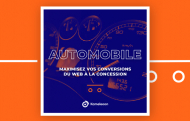
Maximizing automotive conversions with personalization and A/B testing
The automotive market is currently undergoing major, transformative change. The adoption of electric vehicles is radically changing the type of cars that people buy, introducing new competitors and widening choice.
How people research and buy cars is part of this change - digitisation means that a larger part of the process is now carried out online and through touchpoints such as mobile devices. These don’t provide the same face-to-face contact that a visit to a car dealership delivers, making the personalized experience on an automotive brand’s website increasingly vital to driving conversions.
Digitisation is also accelerating buying cycles for cars - it is now possible to read detailed brochures, compare different types of vehicles using specific criteria and even design your future vehicle online, without needing to physically interact with a dealership or brand. Research from Google shows the impact of this. Over three-quarters (76%) of new vehicle buyers need less than two months to purchase, compared with 72% in 2017, while nearly a third (32%) of new vehicle buyers require under two weeks to choose, compared with 27% in 2017.
1 How do brands deliver on these needs digitally?
Traditionally car dealers were the frontline when it came to engagement between automotive brands and potential purchasers. Instead, given the vital importance of digital channels, the company website is now the first port of call for buyers. This means that websites have to deliver in three key areas:
- Increasing digital engagement by projecting consistent brand values and match visitor expectations
- Reassuring visitors through a high-quality experience that provides the information they need to make an informed buying decision
- Personalizing the experience, delivering the same level of tailored service as from a dealership
All of these needs can be met through the use of A/B testing and personalization software - enabling automotive brands to improve the overall experience for all, and to provide the personal service that consumers require.
To help automotive brands maximize the flow of conversions from web to dealerships Kameleoon has created a free ebook, based on the experiences of leading automotive companies. Download it here.
2 3 challenges to online automotive conversions
An automotive website is increasingly central to the sales process, acting as the startpoint of the buying journey and funnelling leads through to dealerships.
For such a major, one-off purchase the customer needs help to convert, making the challenges for automotive brands different to more general e-commerce retailers. There are three to overcome:
Identify buyers earlier in the buying process
Most car companies don’t yet offer the chance to buy a new vehicle online, making the goal of an automotive website to generate test drive requests that can then be passed to dealerships. What is critical is identifying those looking to buy from amongst the thousands of visitors a site receives. .
Automotive brands can benefit from using:
- A/B testing to improve usability for every visitor
- Personalization to match the marketing actions offered to visitors to their specific needs
- AI personalization to identify future buyers through their behavior on the site, and then automatically trigger the right actions to drive conversions.
Read how Renault has improved the user experience with Kameleoon in our new ebook.
Meet their needs in specific part of the purchase funnel
Consumers expect a website to deliver a personalized experience, according to where they are in the purchase funnel. Brands should therefore be capable of adapting the journey, content and messages, just as a sales advisor in a car dealership would.
Brands can overcome this challenge with:
- Personalization to adapt the experience, based on pre-established criteria. For example, if someone has already visited the page of a certain vehicle category more than once, a brand can adapt what is displayed to highlight relevant offers on their next visit.
- AI-driven personalization, allowing a brand to trigger specific actions depending on the conversion probability of each visitor. This maximizes conversions and minimizes waste.
Learn how Toyota is benefiting from Kameleoon’s AI personalization in our new ebook.
Project a reassuring brand image throughout the buying journey
An automotive website has to replicate the brand experience provided within a dealership, delivering reassurance that consumers will receive a quality service and helping them feel confident in moving forward in the buying journey.
The website user experience is therefore crucial, and brands can optimize this through:
- A/B testing to trial different versions of elements within a site, enabling an automotive brand to identify the one that resonates best with users. Improving usability ensures a brand projects a flawless brand image to every visitor.
- Personalization and AI-driven personalization to deliver a tailored experience to each and every visitor, based on their behavior and needs. Providing a personalized experience similar to that received within a dealership ensures that the same brand image is provided across the digital and physical worlds.
Find out how Dacia is engaging visitors on its homepage with Kameleoon in our new ebook.



